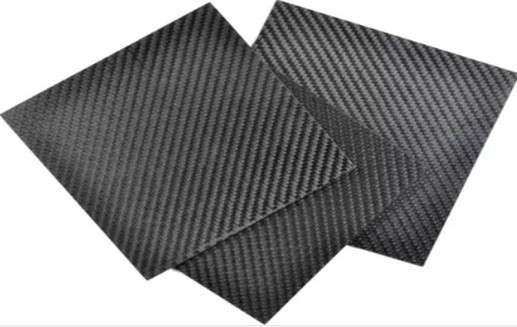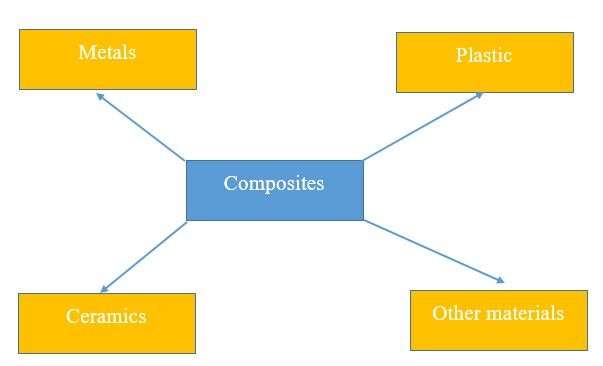![]()
CNC machining of composite
CNC machining is becoming increasingly popular across the manufacturing industry because it can process an extensive range of materials. CNC machining allows the creation of accurate parts of different materials according to the 3D model.
Some typical materials in CNC machining projects include metal & alloys, plastics, and composites. If you analyze the material trend, after metal & plastic, composites are the most common materials in CNC machining projects. This article is all about the CNC machining of composites. We will cover the properties of composites, circumstances for composite machining, applications, and many more.
Related: Common Materials for CNC Machining
What Are the Composites?
Composites are materials made from a combination of two or more materials of different properties. Combining materials with distinct physical and mechanical properties creates a new material with unique properties (Ngo, 2020).
Composite= Base material (Matrix) + fiber (reinforce material)
However, it might also contain other additives and fillers to customize the required properties and get a better surface finish.

Composite-carbon fiber
The fundament’s purpose of combining different types of metal is related to enhancing strength, stiffness, heat resistance, and other properties.
For example, combining ceramics with cast iron increases heat resistance and strength, and the new material formed by the combination will be superior to the parent material in many aspects.
There are four types of composites that are frequently utilized in CNC machining.
- Wood composites: Plywood
- Reinforced plastics: Carbon fiber, fiberglass, textile fiber, and more
- Metal matrix composites: Continues fibers, silicon carbide, graphite, etc.
- Ceramics matrix composites: Alumina, mullite or alumina Silica, calcium-alumina, and more.
What Are the Properties of Composites?
Composites offer resistance to corrosion, a high strength-to-weight ratio, radar transparency, non-magnetic, simple to maintain, durability, consolidation of parts, dimensional consistency, customized surface, and many other properties. Let’s discuss the significant properties in more detail.
- High mechanical strength
If you consider the weight of composites, they are too strong materials. You can understand it by the example of carbon fiber, which offers four times more strength than mild steel. However, the strength of particular composites heavily depends on their constituent materials.
- Fire resistance & retardant
Ceramics and other closely related composite materials are highly fire-resistant. The additives in composites, such as antimony trioxide, create carbon dioxide when a fire starts and stops it from burning. Additionally, they are helpful for the post-ignition cure.
- Impact resistance
A blend of different materials makes composites extremely resistant to shocks and high-impact forces. It can withstand the rapid impacts on the material without sacrificing mechanical properties and breaking.
- Chemical resistance
Composite withstand the invasion of a diverse range of acids, alkalis, and other chemicals along with strong weather resistance capabilities. It primarily relies on the resin used in the production process. As a result, composite materials are utilized to make chemical storage facilities, pipelines, funnels, ducts, pressure vessels, and automobile bodywork.
- Electrical insulation
Composites are excellent electrical insulators that resist high-voltage electrical energy without burning or minor damage. If you examine the application sides, you will see that most electrical insulations used in heating systems, including furnaces, industrial hardening equipment, and many more, employ composites.
Try Prolean Now!
CNC Machining Process with Composites
Processing the composites with CNC machining operations differs from metal, alloys, and plastics. The reinforced elements make it highly abrasive. Additionally, the anisotropic and non-homogeneous structure is responsible for the machining difficulties.
Therefore, it is crucial to consider various machining circumstances to convert the 3D model into functional composite parts without damaging the workpiece and cutting tools.
- Composition of materials
The properties of a particular composite, including the machinability, revolve around its constituent materials, and you need to know these constituents before processing the composite workpiece. Which metal, plastic, ceramic, or additives are included in the composites, and what are the original properties of these constituents?
- Tool material
The material of cutting tools influences their lifespan. Choosing the suitable tool material is essential to avoid physical harm to the workpiece and tool wear. Regular carbon steel or carbide tools can machine the composites. But, they need to be changed frequently as they will suffer a high amount of wear & tear and affect the machining accuracy.
The best technique to prevent such issues and ensure production precision is using veined-diamond tooling. Polycrystalline diamond (PCD) tips can offer quality results when milling and turning composite materials.
- Consider the tool-geometry
The hanging of chips with the workpiece is another issue while working with composite materials, which can be avoided by applying sharp tools. Additionally, tools with high positive rake angles can efficiently make crisp, clean cuts while generating the least heat.
- Helix cutters for trimming.
- End-mills for slotting and pocketing.
- Diamond drills (with modified brad point) for drilling and chamfering.
- Ensure the perfect tool holding
The tool holder is another paramount for Composite CNC machining to prevent the risk of tool pull out. Using a hydraulic chuck with a retention knob is recommended, which balances the machining assembly.
- Use appropriate coolants
The attachment of chips with the workpiece is quite common while processing the composites with CNC technology. Chips can build up heat and harm the tools, and using the appropriate coolant is necessary to tackle this issue.
Ordinary coolants such as water and oil can dissipate the heat, but the problem is that they can absorb these coolants and result in swelling of the workpiece. Therefore, it is best to apply the lubricant or air gun as a coolant. Another solution is the installation of cryogenic cooling systems along with the CNC machine.
For a better finish and to increase the tool life, feed the composite workpiece in the direction of tool rotation- conventional milling. It will facilitate the maximum cutting depth, use full flute length, and maintain stability.
In addition, ensure that the tool is fully engaged with the workpiece and that there is no deflection.
- Cutting speed & feed rate
Machining of composites might be challenging without suitable cutting speed and feed rate. Using high cutting speed and feed rate is recommended to make the process easier and more effective.
- Cutting speed: 550 to 760 meters/ minute or 0.076 to 4.57 mm/tooth
- Spindle speed: above 15000 RPM
Source: (Composite machining: 10 tips to improve tool life and part quality, 2019)
Additionally, these parameters must be changed following the particular CNC machining process and composite type. For example, if the composite is too solid, reduce the spindle speed by one-third, even less than this for drilling.
Advantages & Disadvantages of Composites CNC Machining
Processing composites to create functioning parts has various benefits. It can be customized according to the required properties for end use. Parts with complex geometry can be created at competitive prices with high dimensional accuracy.
However, working with composites might be challenging since it demands specialized tools and various machining circumstances.
Applications of Composites CNC Machining

CNC-machined composite part
You are aware of the advantages of converting composite materials into functional parts and products since we have already covered a variety of composite properties in this article.
Let’s go into further depth about the applications of composite CNC machining.
| Industry | Applications |
| Aerospace | Wings, fuselages, bulkheads, solar reflectors, engine bay doors, turbine blades, fan blades, rotor shafts, etc. |
| Automotive | Panels, frames, Air-intake manifolds, Battery casings, bumpers, interior, heat shield, driveshaft, chassis, slide panel, fender, and other parts. |
| Energy | Hydrogen storage system, wind turbine parts, Construction: doors, wall panels, roofing, window frames, and more. |
| Oil & gas | Oil and gas refineries, water treatment facilities, grating, ducts, hoods, pump cabinets, etc. |
| Defense | Ballistics and weapon parts, aerial drones, launch vehicles, the body of military vehicles, submarine parts, etc. |
| Electrical & electronics | Switchgear, motor controls, standoff insulators, control system parts, circuit breakers, arc shields, terminal blocks, terminal boards, lighting components, and more. |
| Marine | Boat hulls, bulkheads, Pipe fittings, liners, Scrubbers, and many more. |
| Sports | Surfboards, table tennis boards, Tennis rackets, slats, fishing rods, baseball bats, hockey sticks, pole shafts, etc. |
Summing Up
Composites are versatile engineering materials that offer design flexibility and manufacturing economy for various CNC precision machining projects. Different types of composites are machinable and can convert complex 3D models into function parts using CNC technology. It has exceptional properties and provides the leverage for the customization of physical, mechanical, and chemical properties according to the end application.
Accurately machining composites involves various considerations, such as tool material, tool geometry, holding of a workpiece, and many more. It might be confusing to select the perfect machining criteria for your project. But don’t worry; ProleanTech can clear up all your uncertainty and deliver the best result. We have expert engineers to help you find the best geometry and variables for your project.
Read more: Zinc Machining: Alloys, Processes, and Applications
FAQ’s
What are the common composites used in CNC machining?
The most popular composites used in CNC machining include metal matrix composites, carbon fiber, ceramics, reinforced plastics, fiber-reinforced polymers, and fiberglass.
Which properties make composites popular engineering materials?
Composites are a popular engineering material that offers excellent mechanical strength, impact resistance, thermal insulation, electrical resistance, chemical & weather resistance, fire retardant, and many more properties.
Is it easy to process composites with a CNC machine?
It might be challenging to process composites with ordinary tools and machining circumstances, but it can be done by considering the various criteria. Choosing a specific tool, geometry, cutting speed, feed rate, and perfect coolants would be best.
What are the applications of composites CNC machining?
CNC -machined composite parts are applicable in automotive, aerospace, Construction, marine, energy, oil & gas, electrical, electronics, sports, energy, and many more industries.
Bibliography
- (2019). Composite machining: 10 tips to improve tool life and part quality. SANDVIK Coromart, from https://www.sandvik.coromant.com/.
- Ngo, T. (2020). Introduction to Composite Materials. ResearchGate.




Fascinating article! I was intrigued by the specific challenges and techniques mentioned for CNC machining of composites. Could you elaborate on how these techniques differ when dealing with particularly tough composite materials?”
Thank you for your interest! Yes, machining tough composites does require specialized techniques. Typically, this involves selecting the right tooling materials, adjusting cutting speeds, and using specific geometries to manage the abrasiveness and hardness of these materials effectively.
You have mentioned that Cutting speed for composite is 550 to 760 meters/ minute or 0.076 to 4.57 mm/tooth
and Spindle speed above 15000 RPM. Does that work in all conditioned
That is the general range, the exact parameters you need to fixed during composite machining depends on several factors, composite type, required finish, type of cut ,etc.
How much cost for Carbon-fiber machining?
Rokatera, it depends on several factor, from complexity to precision. You can upload design and request the quote to know how much your specific project cost?
We are a small business works on micro CNC milling? We always face rapid tool wear during carbon fiber machining? What could be the reasons?
YAMA,
Rapid tool wear during carbon fiber machining can be attributed to several factors. First, the abrasive nature of carbon fibers can quickly dull cutting tools, especially if they are not made from sufficiently hard materials like diamond or polycrystalline diamond (PCD). Additionally, improper tool geometry and incorrect cutting parameters, such as speed and feed rate, can exacerbate wear and reduce tool life.